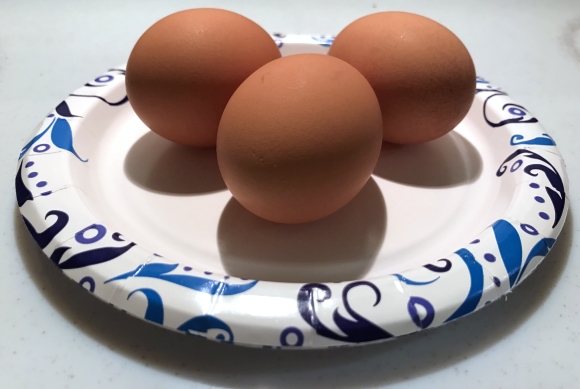
4/10/2022 – There is an old saying, “You can’t make an omelette without breaking a few eggs” which is where Part 1 took me… lots and lots of broken eggs. The breakage began when I chose to ignore everything experience had taught me about the 7.62x39mm in pursuit of theoretical purity. Unfortunately, experience is the foundation of common sense. Once that was set aside, it was a quick trip through Dante’s, “Lasciate ogne speranza, voi ch’intrate“. Fortunately, after slapping my own face a number of times, a moment of clarity followed…
Proper bullet size; useful or needless and oppressive constraints?
The SAAMI standard bullet diameter for the 7.62x39mm cartridge is 0.3110″ +0.0000″/-0.0020″. The SAAMI standard for the 7.62x39mm rifling groove diameter is 0.3100″ +0.0020″/-0.0000″. While the bullet diameter is 0.3110″, it is common for 0.308″ bullets to appear in mainstream reloading data as they do not pose a safety concern, they yield OK accuracy and they offer an extended selection of bullets weights and types.
That said, 0.308″ diameter bullets were purged from Real Guns 7.62x39mm reloading data when a lot of noisy shooting and velocity and accuracy data collection showed the 0.308″ diameter bullet loads were erratic in some or all of those categories. The degree of inconsistency varied with bullet weight, but also with bullet construction.
I tried to pair specific characteristics affecting the problem, but I lacked the moral fiber and intestinal fortitude to stay with the project. So based on empirical findings, 0.308″ bullets were excluded from this project and more correct bullets were substituted.
Still four bullets as in part I, but not the same four bullets…

The four bullets pictures are of common construction; lead core, copper jacket and flat based. In terms of applications, L-R: Hornady 123 grain Interlock from varmint under 50 lbs to deer weighing 300 lbs, Sierra Pro Hunter 125 grains designed specifically for hunting with the 7.62x39mm, Speer Hot-Cor 150 grain intended for medium size game such as deer, Sierra Pro Hunter 180 grain which was not designed for the 7.62x39mm but rather larger capacity cartridges. All applications predicated on supersonic loading.
What are we doing with a silencer hanging off the barrel? Silencers, suppressors as engineers mislabel them, dramatically reduce report and recoil whether or not a bullet is traveling subsonic or supersonic. The only difference is that the silencer will not cancel out the mini sonic boom that accompanies supersonic bullet flight. The influence is good for hunters, good for neighbors and good for shooter’s ears.
Why the subsonic loads? They are effective relatively close up, they work well for Maine’s coyote night hunting season, they are useful for security applications. Of great importance, shooting subsonic through a silencer is fun and developing loads presents an interesting challenge. Why the heavy bullets? If a cartridge is being loaded below its potential velocity and at low pressure levels, the heavier the bullet, the better as all bullets will be leaving the rifle’s muzzle as slightly below the speed of sound, 1125 fps. Yes, that speed of sound only applies in my backyard, and only during the months of May through September.
So the effort has been to develop loads just under the speed of sound threshold and then test and work on accuracy. To that end…
Lee Precision… if I have to
Dies on hand for the 7.62x39mm were Lee Precision with Factory Crimp collet die with expander for 0.308″ bullets (0.307″) and 0.311″ bullets (0.310″”). I’m not a big Lee Precision fan beyond the low cost of their equipment, which allows a lot of folks to enjoy reloading who might otherwise not do so. In this case, the dies provided what was needed.
A note on the collet crimp die. A number of bullet manufacturers recommend against its use where no cannelure is present. I can say that the crimp die subtly, but visibly deforms plain shank bullets even when used as per the instructions. Up close, inside 200 yards, not a problem. Long range, 300 yards and greater, the collet has an impact on bullet aerodynamics, center of gravity and center of pressure.
Trail Boss charges and cheap calipers
Trail Boss is a good reduced charge powder. It is like miniature Cheerios that flow through measures and scale pans without sticking. They are… light and fluffy and case filling, which makes for uniform pressures and its low density make it tough to over/under a charge.
The way that to establish minimum/maximum loads where cartridges are not listed or data is not available is relatively straight forward; set the overall cartridge length, then lay the bullet next to the case with that same overall length and mark the position of the bullet heel on the outside of the case. Alternatively, you can hold the bullet in one hand, the case in the other hand and the market in the other hand.
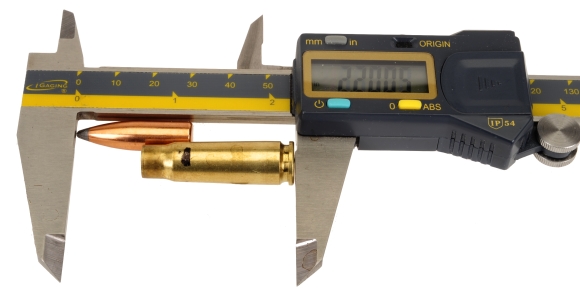
Fill the case with Trail Boss to that mark and weigh the charge. That is the preliminary maximum charge. 70% of that load is the preliminary minimum charge. So multiply the maximum charge by 0.7 to arrive at the minimum charge. Trail Boss should not be compressed as results can be inconsistent. Also, these are labeled preliminary because this will change with live fire testing.
Note – I do not use my $900 Starrett on the bench because… we’ll, I don’t own one. Why would I buy a $900 tool, when a $56 tool reliably does what I need? This one has been in heavy use since March 3, 2016. But what do I do when a measurement must read to one ten thousandths of an inch? I use a precision micrometer. The notion of accurately measuring to the tenth thousandths with a digital caliber is a work of fiction.
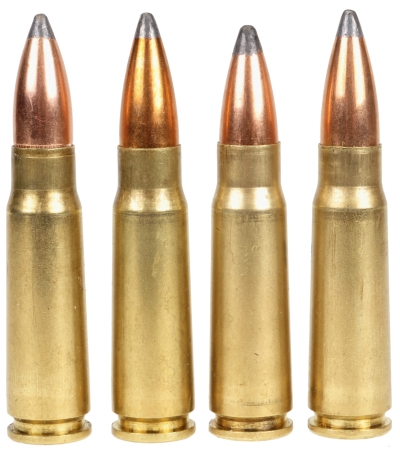
So how accurate was the 70% – 100% min – max approach in meeting my handload objectives? Let’s take a look, shall we?
| Bullet | Weight Grains |
Bullet Length |
Seating Depth |
COAL | Min Trail Boss |
FPS MV |
Max Trail Boss |
FPS MV |
| Hornady | 123 | 0.875 | 0.200 | 2.200 | 6.0 | 1031 | 8.6 | 1216 |
| Sierra | 125 | 0.900 | 0.223 | 2.200 | 5.9 | 850 | 8.4 | 1259 |
| Speer | 150 | 1.000 | 0.393 | 2.130 | 5.6 | DNCB | 8.0 | 751 |
| Sierra | 180 | 1.190 | 0.513 | 2.200 | 5.0 | DNCB | 7.1 | DNCB |
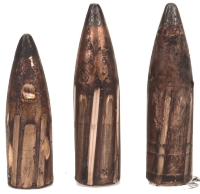 So using the recommended approach to starting loads resulted in a little good news and a little bad news, The good news was that the 123 grain and 125 grain loads were close enough to be useful as a basis for further development. Additionally, where the bullet did not have enough steam to clear the barrel (DNCB), the discharge was incredibly quiet… Yes, the latter is sarcasm… possibly irony.
So using the recommended approach to starting loads resulted in a little good news and a little bad news, The good news was that the 123 grain and 125 grain loads were close enough to be useful as a basis for further development. Additionally, where the bullet did not have enough steam to clear the barrel (DNCB), the discharge was incredibly quiet… Yes, the latter is sarcasm… possibly irony.
The bad news? The heavy bullets did not have bracketing velocity values that would have allowed tweaked between low and high results. Increased powder charges pushed pressures up, but pressure persistence was insufficient to overcome bullet weight resistance and increased bore friction. It became doubtful that net case capacity was insufficient for Trail Boss. Still we endeavor…
| Bullet | Weight Grains |
Measured Bullet Length |
Seating Depth |
COAL | Trail Boss | FPS MV |
| Hornady | 123 | 0.875 | 0.200 | 2.200 | 7.5 | 1192 |
| Sierra | 125 | 0.900 | 0.223 | 2.200 | 7.5 | 1153 |
| Speer | 150 | 1.000 | 0.343 | 2.200 | 9.0 | 894 |
| Sierra | 180 | 1.190 | 0.436 | 2.275 | 9.0 | 663 |
Charges were modified as prior testing suggested. While still low pressure, the heavier bullets were backed by nearly twice the chamber pressure of the lighter bullets and heavy bullets were at maximum charge based on case volume.The light bullets were still supersonic. The heavy bullets went subsonic, but too slow to be useful and too slow to stabilize. A quick live fire check of the heavy bullets produced 6″ groups and signs of tumbled projectiles. Those results led to…
| Bullet | Weight Grains |
Measured Bullet Length |
Seating Depth |
COAL | Trail Boss | IMR 4227 | FPS MV |
Relative MAP PSI |
| Hornady | 123 | 0.875 | 0.200 | 2.200 | 7.2 | – | 1115 | 17388 |
| Sierra | 125 | 0.900 | 0.223 | 2.200 | 7.4 | – | 1135 | 18647 |
| Speer | 150 | 1.000 | 0.343 | 2.200 | – | 11.0 | 1035 | 11168 |
| Sierra | 180 | 1.190 | 0.436 | 2.275 | – | 11.0 | 831 | 13245 |
Very close on the Trail Boss loads. Very close on the 150 grain. Still off in the weeds on the 180 grain. So the 123 grain was shaved 0.1 grain of Trail Boss, the 125 grain was shaved 0.2 grains of Trail Boss. The 150 grain was bumped up 0.1 grain of IMR 4227. As the 180 grain IMR 4227 loads had lots of excess capacity, the bullet seating was adjusted downward for an overall cartridge length of 2.200″ and the charge was increased to 13.5 grains. Which resulted in…
| Bullet | Weight Grains |
Measured Bullet Length |
Seating Depth |
COAL | Trail Boss | IMR 4227 |
FPS MV |
Relative MAP PSI |
| Hornady | 123 | 0.875 | 0.200 | 2.200 | 7.1 | – | 1086 | 17033 |
| Sierra | 125 | 0.900 | 0.223 | 2.200 | 7.2 | – | 1074 | 17540 |
| Speer | 150 | 1.000 | 0.343 | 2.200 | – | 11.1 | 1079 | 11323 |
| Sierra | 180 | 1.190 | 0.436 | 2.275 | – | 13.5 | 1046 | 20388 |
No, I have no idea how we got here…
A few notes. I know, what the heck is “Relative MAP PSI”? That just means it is not an instrument acquired pressure, it is a calculation from QuickLoad. I see print out of QuickLoad data posted on social media with the suggestion it is hard data. It is not… far from it. The program has major flaws in powder characteristics, charges and velocity. AS the years go by, it seems maintained less and the errors increase.
QuickLoad may be OK for spit balling but, as the author pleads, not to be used as a sole tool for developing handload data. No, you can’t back into the data from factory ammo and tweak parameters to match unless you have instrument pressure data for the factory ammunition.
So, I was unable to wrap up in Part II. However, I did get to 4 subsonic candidates to work out consistent accuracy and that is where I am headed… promise. So stay tuned for Part III and range live fire results.

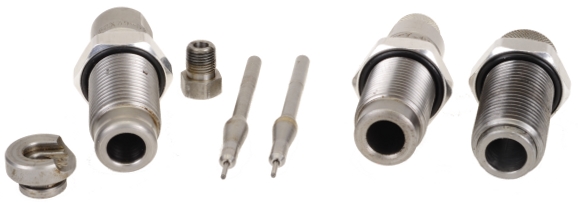
Email Notification